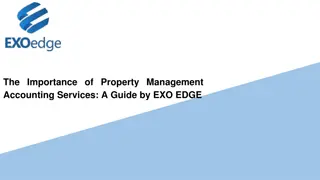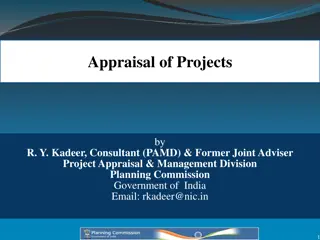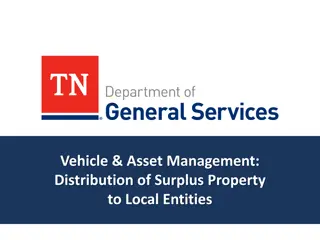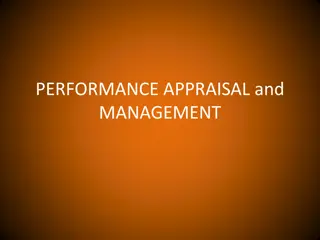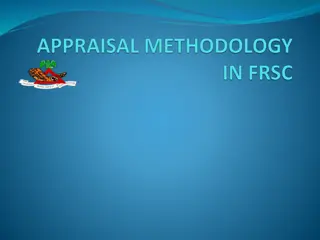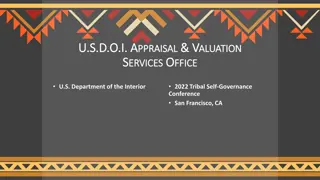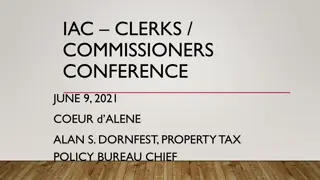Overview of Real Property Appraisal Standards
Explore key standards in real property appraisal such as the Uniform Act, KYTC Appraisal Guidelines, USPAP, and UASFLA (Yellow Book). These standards aim to ensure fair treatment in property valuation processes and acquisitions. Learn about the purpose, development, and significance of these appraisal standards in the real estate industry.
Download Presentation

Please find below an Image/Link to download the presentation.
The content on the website is provided AS IS for your information and personal use only. It may not be sold, licensed, or shared on other websites without obtaining consent from the author.If you encounter any issues during the download, it is possible that the publisher has removed the file from their server.
You are allowed to download the files provided on this website for personal or commercial use, subject to the condition that they are used lawfully. All files are the property of their respective owners.
The content on the website is provided AS IS for your information and personal use only. It may not be sold, licensed, or shared on other websites without obtaining consent from the author.
E N D
Presentation Transcript
A brief overview Part 1 of a series
Part 1 presented by Dale Crump General Certified Appraiser in Kentucky and Ohio Central Office Reviewer Right of Way Program Specialist II Stand-up Philosopher
Part One Controlling Documents
1. The URA or Uniform Act : http://www.fhwa.dot.gov/real_estate/uniform_act/ 2. KYTC Appraisal Guidelines: http://transportation.ky.gov/Right-of-Way-and- Utilities/Documents/KYTC%20Appraisal%20Guideli nes.pdf 3. USPAP: http://www.appraisalinstitute.org/ 4. USAFLA or Yellow book: http://www.justice.gov/sites/default/files/enrd/legc y/2010/11/16/Uniform-Appraisal-Standards.pdf
Uniform Relocation Assistance and Real Property Acquisition Policies Act of 1970, as amended (The Uniform Act): 1. The purpose is to promote the fair and equitable treatment of people displaced as a result of projects undertaken by a federal agency or state agency with federal financial aid. 2. Requires (except under certain conditions) the appraisal of real property before initiations of negotiations.
KYTC Appraisal Guidelines: was established to provide a consistent format for highway appraisals to ensure that fair and equitable treatment of the public is preformed throughout the valuation process on all KYTC approved projects.
Uniform Standards of Professional Appraisal Practices (USPAP): 1. Developed, published and interpreted by The Appraisal Foundation s Appraisal Standards Board on behalf of appraisers and users of appraisal services. 2. Used by state and federal regulatory agencies and others. 3. Contains Definitions, Preamble, Rules and Standards.
Uniform Appraisal Standards for Federal Land Acquisition (UASFLA or The Yellow Book ) 1. Developed and published by the (U.S. Federal) Interagency Land Acquisition Conference. 2. Intent is to promote uniformity in the appraisal of real property among the various agencies acquiring property on behalf of the U.S. 3. Developed in 1973 and revised in 1982 and 2002.
Part 2 Definitions & Terms
Personal Property: is the items that are not affixed to the real estate. They are not transferred with the property but are transferred by a bill of sale. Fixtures: are items that were once personal property but have since been permanently attached to the real estate so that the items are now regarded as part of the real estate. Trade Fixtures: are not part of the real estate. They are personal property no matter how they are affixed. (found usually in rental situations)
Real Estate: is the physical land and appurtenances ( something that has been added to a property and has now become an inherent part of it and usually passes with title) to the land. Real Property: is all the rights, interests and benefits inherent in the ownership of the real estate. It is the bundle of rights. Bundle of Rights: All the rights of real estate ownership. A fee ownership of a real estate parcel that includes possession, enjoyment, disposal, etc. Any one, or several, of the rights may be transferred or conveyed to another, with the owner retaining any rights not conveyed.
Appraisal: is the act or process of developing an opinion of value . (USPAP) An appraisal is a written or verbal statement independent and impartially prepared by a qualified appraiser setting forth an opinion of defined value of an adequately described property as of a specific date, supported by the presentation and analysis of relevant market information. (The Uniform Act of 1970)
1. An adequate description of the physical characteristics of the property being appraised (and in the case of partial acquisition, an adequate description of the remaining property) including items identified as personal property, a statement of the known and observed encumbrances, if any, title information, location, zoning, present use and analysis of highest and best use, and at least a 5 year sales history of the property.
2. All relevant and reliable approaches to value consistent with established federal and federally assisted programs appraisal practices. If the appraiser uses more than one approach, there shall be an analysis in reconciliation of approaches to value used that is sufficient to support the appraiser s opinion of value.
3. A description of comparable sales, including a description of all relevant physical, legal, and economic factors such as parties to the transaction source and method of financing, and verification by a party involved in the transaction.
4. A statement of the value of the real property to be acquired and, for a partial acquisition, a statement of the value of the damages and benefits, if any, to the remaining real property where appropriate.
5. The effective date of valuation, date of the appraisal, signature, and certification of the appraiser.
Cost:(as it relates to real estate valuation), is the amount spent to construct an object or improvement. While there are various types of cost, the most common ones in valuation are replacement cost (equivalent utility) and reproduction cost (exact replica). Price:is the amount paid for a good or service. In real estate, the transaction price is the amount for which a property actually sells. Value:is the worth of a good or service at a particular time. In real estate, there are several value types.
D.U.S.T Demand:includes not only the desire or need for real estate, but also the financial ability to meet the demand or need. Utility: In order for real estate to have value, it must have utility or usefulness. It must have the ability to satisfy wants, needs and desires. Scarcity: it is the supply of real estate in relations to demand. Transferable: in order for real estate to have value it must be transferable, the ownership rights must be able to pass from seller to buyer.
Economic factors: affect the management of limited economic resources. Environmental factors: include both the natural environment and the developed environmental characteristics. Governmental factors: zoning, tax levies, educational system, building codes, et. Social factors: relate to the demographic characteristics of age and gender composition, population, population changes and social attitudes.
Part 3 The Valuation Process
The reasonably probable and legal use that is physically possible, appropriately supported, financially feasible and that results in the highest value. Physically possible Legally permissible Financially feasible Maximally productive
The appraiser uses one or more of the three approaches to develop value opinion. Each approach has its applicability and its strengths and weaknesses. The three approaches to value are: Cost Sales Comparison Income Capitalization
Cost Approach Develops a value of opinion for the land, Estimates the cost new of the improvement, as of the appraisal effective date, Deducts depreciation from the cost new of the improvement, Adds the land value opinion and the depreciated improvement value indication for the subject property by the cost approach.
Cost Approach cont. There are three primary methods to estimate the cost new of the improvements. The comparative-unit method, the unit-in-place method,and the quantity survey method. The Comparative-unit method is the most frequently used (e.g., dollars/per square foot, dollars per cubic foot) Cost new = reproduction (exact copy) vs. replacement (equivalent utility) minus depreciation.
Cost Approach cont. Depreciation is a loss in value from any and all causes. It is the difference between the cost new and the depreciated value, as of the appraisal effective date. Depreciation results from three causes, physical deterioration, functional obsolescence and external obsolescence.
Cost Approach cont. There are threebasic methods to estimate depreciation. The age-life method, market extraction methodand the breakdown method. The age-lifemethodis most frequently used. Age- life method is the ratio between effective age and economic life.
Sales Approach In the sales comparison approach, the appraiser compares recent similar property sales to the subject property. The sales are adjusted for the dissimilarities to the subject and an indicated value of opinion for the subject property is developed. If the sale is superior in a specific attribute, a minus adjustment is indicated, if the sale is inferior in a specific attribute, a plus adjustment is indicated, if the sale and subject are comparable in a specific attribute, no adjustment is made.
Sales Approach cont. Adjustment can be qualitative (inferior to, equal to, superior to) or quantitative (dollars, percentages) Quantitative is the preferred method used on Highway Appraisals Typical adjustments considered include property rights, financing, sales conditions, market conditions, location, physical characteristics, other.
Income Capitalization Approach In developing a property value opinion by the income capitalization approach, the appraiser converts income into value through the application of a rate or a ratio. Gross Rent Multipliers: express the relationship between value and gross rent. GRM= Sale Price/Gross Rent GRMs are appropriate for residential properties. In this instance, the gross rent and the gross rent multiplier are generally based on monthly rent.
Income Capitalization Approach cont. To develop a gross rent multiplier, the appraiser, researches the market for recent similar sales that were rented or available for rent at the time of sale. Next, the gross rent multiplier is determined by dividing the sale price by the gross rent. Once developed, the appraiser multiplies the subject property s gross rent by the gross rent multiplier to arrive at a value opinion for the subject property.
Income Capitalization Approach Direct Capitalization 1. Estimate the subject property s annual potential gross income (PGI) 2. Determine a vacancy and collection loss (V&C) 3. Subtract the vacancy and collection loss from the potential gross income to arrive at the effective gross income (EGI)
Income Capitalization Approach Direct Capitalization 4. Estimate annual property expense and subtract the expenses from the effective gross income to arrive at the net operating income (NOI) 5. Develop a capitalization rate. 6. Convert the net operating income into value through the application of a rate.
Income Capitalization Approach Direct Capitalization In the development of a market value opinion, the appraiser converts the net operating income into value through direct capitalization or yield capitalization. In direct capitalization, the formula is: Property Value= Net Operating Income/Capitalization Rate
Part 4 Highway Appraisals
APPRAISAL TECHNIQUES The regulations found in 49 CFR Part 24 provide that the format and level of documentation for an appraisal depend on the complexity of the appraisal problem. The documentation must include valuation data and the appraiser s analysis of the data. In some cases, the appraisal problem will allow that minimum standards be used; others may require a detailed appraisal. However, any appraisal must contain sufficient documentation to support the appraiser s stated opinion of value.
These type of appraisals generally use two values, Before and After (BAV). But there are times when the scenario does not require a complete BAV or when there is sufficient data that only one approach to value is required. Minimum standards considerations must take into account the type of appraisal needed and the appraisal context, consistent with state appraisal standards. For example, eminent domain appraisals typically require more thorough data research, more in-depth analysis and more complete documentation and reporting than appraisals prepared for the mortgage lending industry. (BV & MINOR)
In the Before, the appraiser considers the entire property and then takes the contributing value of each component to the whole, i.e., land, site improvements and all structures in its current use and gathers, analyzes and assembles market data to arrive at a opinion of value before the road project is constructed. In the After situation, the appraiser considers any value loss to the fee simple and easements taken and any damages that the new construction may have on the parcel, i.e. but not limited to, proximity to the new road, elevation changes, curable functional obsolescence and changes in highest and best use.
MINIMUM STANDARD APPRAISALS This form of appraisal may be utilized for whole residential acquisitions, acquisitions of vacant land or for partial acquisitions involving easily supported damages to the remainder of the property. In all instances, the highest and best use must be the same both before and after acquisition. The report must include a description of the property and the acquisition, an analysis of the comparable sales used, photographs of the property and an analysis of the value conclusions.
Questions and/or Comments? https://encrypted-tbn2.gstatic.com/images?q=tbn:ANd9GcSyXoTZ-1zQhQGVDoUOVZjnHkxucSZg1xwccnDzq_UalC2OcJWTeurQKQ
Thank you for your time and attention









